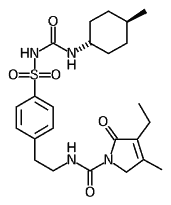As the number of individuals with diabetes, especially type 2 diabetes, continues to rise, and the importance of achieving glycaemic targets is ever more apparent, we are treating more intensively, addressing attendant cardiovascular risk and applying all the rigor of good practice. Yet good control is often elusive for a substantial proportion of patients. (Bar the occasional game of golf) this cannot necessarily be blamed on the physician or (apart from occasional overindulgence or lack of compliance) the patient: it is the progressive natural history of a complex disease process that presents a 'moving therapeutic target' for which we do not always have exactly matching medications available. Hence the need for new therapies.
[ILLUSTRATION OMITTED]
Combination therapy
Fixed-dose combinations are emerging around the world and in the UK, where we currently have Avandamet (a combination of metformin and rosiglitazone). Such combinations can assist compliance by reducing pill burden and allow lower doses of two agents to be used to achieve control while improving tolerance and reducing side effects. It is likely that other fixed-dose combinations of existing oral antidiabetic drugs will be introduced (e.g. metformin with pioglitazone, and rosiglitazone with glimepiride). Combinations of metformin and sulphonylureas are available in some countries, and further ahead there is the possibility of combining antidiabetic agents with antidyslipidaemic and/or antihypertensive agents.
Incretin mimetics
Analogues of the incretin hormone glucagon-like peptide-1 (GLP-1) are being developed to enhance glucose-induced insulin secretion after a meal. They act through a different cellular mechanism to sulphonylureas and meglitinides, and offer a range of other interesting effects such as mild satiety, slowing gastric emptying, reducing weight and suppressing glucagon secretion. Most enticing are the preclinical studies (Deacon, 2004) showing increased [beta]-cell division and neogenesis, and evidence that this can occur in a clinical context is eagerly awaited. At present the preparations require subcutaneous injection and have been reported to cause nausea, but hopefully severe hypos should not occur, at least if given as the only antidiabetic medication. Most advanced in development is exenatide, a molecule originally found in the saliva of an American lizard.
Inhibitors of the circulating and cell-surface enzyme dipeptidyl peptidase-IV (DPP-IV) act, at least in part, by preventing the degradation of endogenous GLP-1, so producing a similar spectrum of effects to GLP-1 analogues. Conveniently, these agents are orally active, but it has to be remembered that DPP-IV inhibitors can prolong the half-life and increase the activity of a range of other peptides, which could influence their therapeutic profile (Drucker, 2003).
Other agents
A cannabinoid receptor-1 (CB1) inhibitor (rimonabant) has recently been shown to assist lifestyle measures as an antiobesity agent. It reduces appetite and reduces fat deposition, particularly in abdominal adipose tissue (Van Gaal et al, 2005). Additionally this agent is helpful in smoking cessation (and preventing weight gain during smoking cessation), reducing triglycerides and improving insulin sensitivity in obese people with diabetes. It is an oral agent, and if the side effect profile is as encouraging as the initial clinical trials, this could be a valuable new treatment.
Inhaled insulins are attracting much interest, and a dry powder preparation (Exubera) is presently being evaluated by regulators. This could be most useful in providing prandial bolus delivery of rapid and short-acting insulin to supplement injections of long-acting insulin, or to supplement oral agents in type 2 patients. As long as lung function is unaffected, this could be coming soon. Other types of agents advanced in development include the dual PPAR[alpha]-[gamma] agents that act rather like a thiazolidinedione and a fibrate combined, providing a therapy for control of both glycaemia and various lipids.
In the USA, a soluble analogue of amylin (Symlin) has just been approved as an adjunct to insulin therapy that reduces glucagon secretion, slows gastric emptying and helps weight control with a satiety effect.
This is a taste of the types of agents we might anticipate for the future to assist in the treatment of diabetes.
Deacon CF (2004) Therapeutic strategies based on glucagon-like peptide 1. Diabetes 53(9): 2181-9
Drucker DJ (2003) Therapeutic potential of dipeptidyl peptidase IV inhibitors for the treatment of type 2 diabetes. Expert Opinion on Investigational Drugs 12(1): 87-100
Van Gaal LF et al; RIO-Europe Study Group (2005) Effects of the cannabinoid-1 receptor blocker rimonabant on weight reduction and cardiovascular risk factors in overweight patients: 1-year experience from the RIO-Europe study. Lancet 365(9468): 1389-97
Cliff Bailey
Head of Diabetes Research, Aston University, Birmingham. Dr Bailey is key note speaker at the PCDS Conference at The Belfry, Warwickshire, 11-12 November 2005
COPYRIGHT 2005 S.B. Communications
COPYRIGHT 2005 Gale Group



